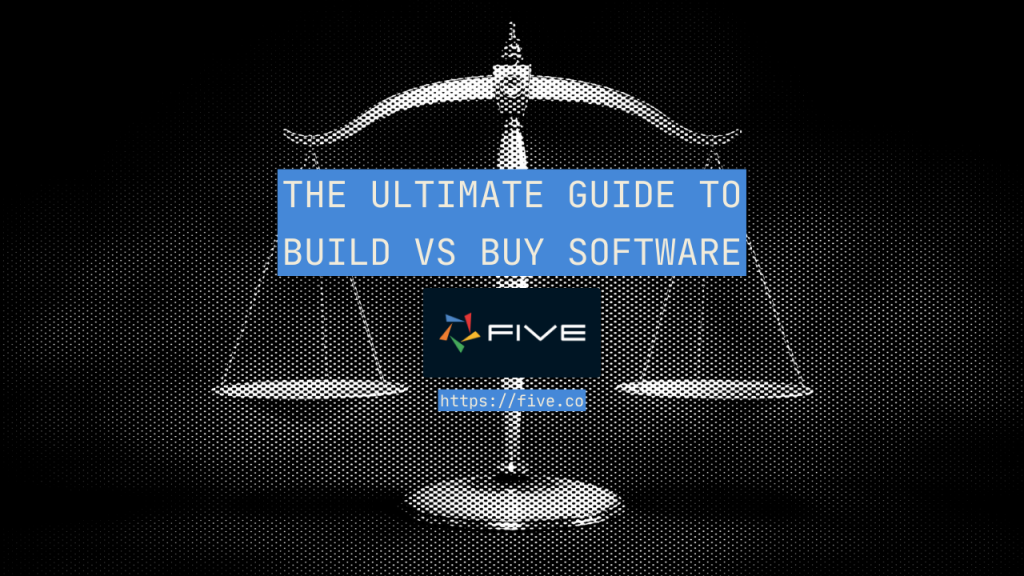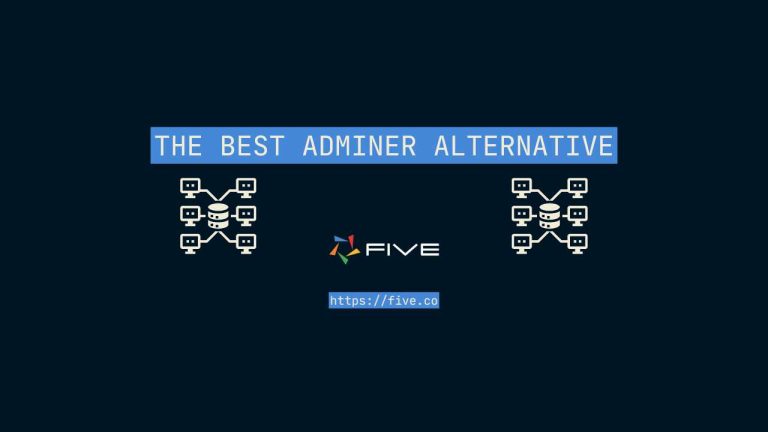Build vs Buy Software [2023 Definitive Guide]

Deciding Between Build vs. Buy Software
Is it better to build or buy software off the shelf? In today’s world of digital transformation, companies are increasingly recognizing the importance of efficient software solutions.
In this blog, we aim to shed light on the key distinctions between building and buying software. Drawing from our experience as software developers, we hope this will give you insights to empower you in making an informed business decision.
Software solutions have a huge impact on how well an organization performs. They make things run smoother, help people work faster, and meet the changing demands of customers and internal teams.
When it comes to adopting software, every organization faces a crucial decision: should they opt for off-the-shelf, ready-made software or embark on the journey of developing tailor-made software solutions that align precisely with their unique demands?
According to statistics by Statista, companies’ information technology spending on enterprise software worldwide is expected to exceed USD 856.03 billion in 2023.
With mounting pressure to build better software faster, a WSJ article predicts that nearly two-thirds of all companies will be software producers by 2025 to cater to this increasing demand.
Table of Contents
Should You Build or Buy Software?
Although developing a tailor-made software solution in-house may initially appear as the optimal approach to tackle a particular business challenge, it frequently demands a disproportionate allocation of resources, particularly in terms of budget and personnel, for the creation, implementation, and maintenance of the software.
In contrast, collaborating with a reputable vendor to deploy a proven solution often proves to be a more efficient alternative.
This approach enables companies to expedite the technology’s availability to users and ensures comprehensive support throughout its entire lifecycle but limits the potential to extend the usability of the software strictly to the vendor’s product roadmap. Let’s dive deeper to understand the pros and cons of both approaches.
The Buy Software Approach
When choosing the buying approach for software solutions, companies can enjoy several benefits that come with ready-made options. Let’s explore the advantages and also the challenges that might arise:
| Pros of Buying Off-The-Shelf Software Solutions | Cons of Buying Off-The-Shelf Software Solutions |
|---|---|
| Immediate availability and quick implementation | Potential lack of customization |
| Reduced development time and costs | Integration with existing systems |
| Rigorous testing and reliability | Ongoing updates and support requirements |
| Includes unnecessary features |
Pros of Buying Off-The-Shelf Software Solutions
- Immediate availability and quick implementation: Off-the-shelf software is readily accessible, so companies can start using it right away. There’s no need to wait for development time, which means faster implementation and getting the technology up and running in no time.
- Reduced development time and costs: Since the software is already built and tested, there’s no need to invest time and money in creating it from scratch. This can significantly lower development costs and accelerate the deployment process.
- Rigorous testing and reliability: Commercial software products typically undergo extensive testing and refinement before hitting the market. This testing ensures a higher level of reliability and performance for general use, giving companies more confidence in their choice.
Cons of Buying Off-The-Shelf Software Solutions
- Potential lack of customization: Ready-made software may not perfectly align with all the specific needs of a company. It might lack certain features or functions that are essential for the organization’s unique processes. And there is no differentiation in using off-the-shelf software.
- Integration with existing systems: When adopting off-the-shelf software, compatibility issues might arise when trying to integrate it with the company’s current IT infrastructure and systems. This can lead to additional effort and costs to ensure a smooth integration.
- Ongoing updates and support requirements: As business requirements evolve, the purchased software may need regular updates and ongoing support. Depending on the vendor’s commitment, the level of support and updates may vary, impacting the software’s long-term viability.
- Includes unnecessary features: In some cases, off-the-shelf software comes with too many features as these software are designed with many different types of users in mind and it might get annoying to navigate through it all which causes loss of productivity.
The Build Software Approach
When opting for building software internally, companies can enjoy several benefits that come with creating custom software.
Let’s explore the advantages as well as the considerations and potential drawbacks:
| Pros of Building Tailored-Made Software Solutions | Cons of Building Tailored-Made Software Solutions |
|---|---|
| Tailored to specific business requirements | Time and resource investment |
| Seamless integration with existing workflows | Specialized expertise and development challenges |
| Increased efficiency and productivity | |
| A competitive advantage over your competitors |
Pros of Building Tailored-Made Software Solutions
- Tailored to specific business requirements: Custom software is designed from the ground up to fit the exact needs of the company. This level of customization ensures that the software aligns perfectly with the unique processes and workflows, maximizing its effectiveness.
- Seamless integration with existing workflows: Since custom software is developed specifically for the organization, it can be seamlessly integrated with the company’s existing IT systems and infrastructure. This integration reduces disruptions and ensures a smooth transition.
- Increased efficiency and productivity: Custom software is designed to address the specific pain points and challenges faced by the organization. As a result, it can streamline processes, automate repetitive tasks, and optimize workflows, leading to improved efficiency and productivity.
- A competitive advantage over your competitors: When deploying custom software that is specifically designed to cater to an organization’s unique circumstances it allows companies to differentiate themselves by providing superior products and services, streamlining internal operations, and providing exceptional customer experiences.
Cons of Building Tailored-Made Software Solutions
- Time and resource investment: Building custom software requires time, effort, and financial resources. The development process can be more time-consuming compared to buying pre-built solutions, as it involves creating the software from scratch to meet the organization’s unique requirements.
- Specialized expertise and development challenges: Developing custom software demands a team of skilled developers and technical experts. It may require specialized knowledge and experience in software development, which could be a challenge for some companies to attract or afford the right talent.
The Hybrid Approach
The hybrid approach to software solutions started to gain traction recently and it involves combining off-the-shelf, ready-made software with custom software to strike the right balance for your organization.
In a study done by Rackspace with 1870 total respondents from the top leadership in tech, one of the key findings is that there is a shift to strategically balance both approaches of build vs. buy software.
The study indicates that tech leaders do not want to spend valuable developer resources building and maintaining applications that won’t significantly set the brand apart. The prevailing trend leans towards opting for buying software solutions whenever feasible while adopting the increasingly popular low-code code development platform for building business-critical applications for maximum flexibility.
This choice aims to achieve a higher Return on Investment (ROI), enhance efficiency, and improve user-friendliness. Additionally, it allows organizations to optimize their resources by freeing up in-house talent to focus on building applications that can deliver more significant impacts on the business faster using low-code solutions.
“56% of Organizations Build Applications In-House To Gain a Competitive Advantage”
Rackspace Whitepaper: Build or buy 2020
“65% of Applications With Be Built Using Low Code by 2024”
Able Platform: Why low-code development is becoming so popular
In summary, the landscape of software solutions is witnessing a dynamic shift, where both build vs buy approaches play significant roles in meeting the diverse needs of businesses.
Undeniably, there is a growing trend towards the “build” approach, as businesses recognize the value of tailored solutions that precisely align with their unique requirements. Building custom software also offers the potential for a competitive edge, enhanced efficiency, and the ability to address specific pain points effectively.
Moreover, the increasing availability of low-code platforms has accelerated the development process, enabling organizations to build applications faster by reusing prebuild components. The current trend towards adopting a mixed strategy demonstrates the recognition that there is no one-size-fits-all solution in the software realm.
The decision to build custom software or buy off-the-shelf systems should be driven by a thorough evaluation of the organization’s unique needs, long-term goals, budget, and available resources.
6 Considerations When Choosing Between Build vs Buy Software
Now that you’re informed of the different pros and cons, you are faced with the crucial choice of selecting between building and buying software solutions, you must approach the decision-making process with care and foresight.
Here are 6 essential considerations to get started:
- Firstly, it’s crucial to thoroughly assess your organization’s specific needs and goals. Identifying the functionalities and features required to effectively address your business challenges will help determine whether existing off-the-shelf solutions can suffice or if custom-built software is necessary for a perfect fit.
- Time-to-market is another critical factor. If rapid deployment is essential to gain a competitive advantage or meet market demands quickly, ready-made solutions might be the most suitable option. Conversely, building custom software may take more time due to development, testing, and deployment processes.
With low code, however, the time-to-market of custom-built solutions has been dramatically shortened, so that nowadays, organizations can build custom software at the speed of implementing off-the-shelf systems. - Budget and cost considerations play a significant role in the decision-making process. Ready-made software often comes with lower upfront costs, while custom software development may involve higher initial expenses. However, custom solutions can potentially lead to long-term cost savings by precisely addressing your needs without unnecessary features.
- Assessing your organization’s in-house expertise and available resources is vital. Building custom software requires skilled developers and dedicated personnel. If your team possesses the necessary expertise and capacity, custom development could be a viable option. However, for organizations lacking the required skills, purchasing software might be a more practical choice.
- Additionally, it’s essential to consider your future growth and scalability requirements. Pre-built solutions often offer established scalability features, making them suitable for rapid expansion. However, custom software can be tailored to adapt seamlessly to your evolving business needs, providing greater long-term flexibility.
- Lastly, factor in the ongoing maintenance and support needs of the chosen software solution. Ready-made software usually includes vendor-provided support and regular updates, while with custom-built solutions, your organization will be responsible for ongoing maintenance, which may require additional resources and expertise.
Conclusion
The choice between building or buying software solutions is a critical decision that can have lasting impacts for years to come. It is essential to approach this decision with a focus on the long-term consequences, availability of resources, urgency with which the solution is required, and an assessment of how critical the system is for your business.
If you are looking to replace legacy software, rapidly build crud apps, or online database apps you should explore Five low-code IDE. Join the hundreds of other software developers who are already using Five to build customer-facing and internal teams-facing web applications, modernize legacy applications, and many more. Get started with a free download of Five now!


